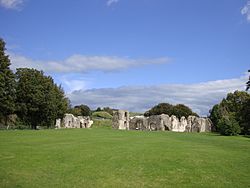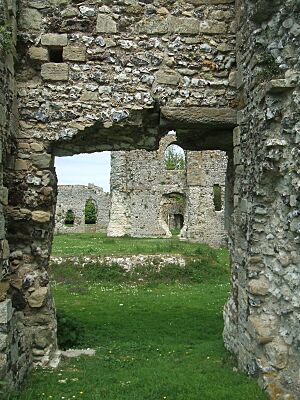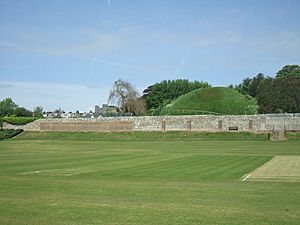Lewes Priory facts for kids

View of priory remains, in the direction of the site of the Great Church (now bisected by railway line)
|
|
| Monastery information | |
|---|---|
| Full name | The Priory of St Pancras, Southover near Lewes |
| Other names | Lewes Priory |
| Order | Cluniac |
| Established | circa 1081 |
| Disestablished | 16 November 1537 |
| Mother house | Cluny |
| Dedicated to | St Pancras of Rome |
| Controlled churches | St. John the Evangelist, Piddinghoe, St. Nicholas. Iford. |
| People | |
| Founder(s) | William de Warenne, Earl of Surrey and Gundrada |
| Site | |
| Location | Southover, East Sussex, United Kingdom |
| Coordinates | 50°52′5.33″N 0°0′29.63″E / 50.8681472°N 0.0082306°E |
| Visible remains | limited above ground: part precinct wall, hospitium, dorter, rere dorter, first church |
| Public access | yes, free all year round |
Lewes Priory is a very old monastery in Lewes, East Sussex, United Kingdom. It was once a large and important religious building. Today, only some parts of it remain as ruins. These ruins are protected as a Grade I listed building. This means they are very important historically.
Contents
History of Lewes Priory
The Priory of St Pancras was the first Cluniac monastery in England. It had one of the biggest church buildings in the country. The Priory was built in a great spot near the River Ouse valley. It was surrounded by high walls and gates.
Key Events at the Priory
In 1264, a big battle called the Battle of Lewes happened nearby. King Henry III and his soldiers went to the Priory for safety. But Simon de Montfort's army attacked them there. King Henry was forced to agree to new rules. This event, called the Mise of Lewes, was an early step towards England's Parliament.
Today, the Lewes Priory Trust looks after the site. Most of the Priory buildings were destroyed a long time ago. This happened during the Dissolution of the Monasteries. This was when King Henry VIII closed down monasteries across England. Some smaller parts of the buildings are still standing. They are in a public park that you can visit. Experts have studied the Priory for many years. In 2009, money was given to fix the old parts and add signs. These signs help visitors learn about the Priory's history.
Founding the Priory
Lewes Priory was started by William de Warenne, 1st Earl of Surrey and his wife Gundrada. This probably happened in 1081. They had visited a similar monastery called Cluny in France in 1077. The Priory was named after St Pancras. This was because there was already an old Saxon shrine to this saint on the site. William de Warenne wanted to show the new Norman rulers were strong and religious.
Exploring the Priory Site
The Priory site is a large area, about 16 hectares (40 acres). It is shaped like a rough square. The northern side is along Southover High Street today. This area was as big as the walled town of Lewes itself.
In medieval times, the south side of the Priory was next to a tidal stream. This stream connected to the River Ouse and then to the sea. So, the Priory was like a coastal location. It was protected by tall flint walls because of possible attacks from the sea. The main Priory buildings were in the western part. The big church was in the north-west corner. The land sloped down towards the south.
In the north-east part of the site, there is a large mound called 'The Mount'. It is about 15 meters (50 feet) high. No one is completely sure what it was for. It might have been part of a salt works. It could also have been a lookout point or a beacon for ships.
Priory Buildings and Design
We know about the Priory's layout from archaeological digs. These digs have been happening since the 1840s. A famous plan of the Priory was drawn in 1906. It shows where the buildings were.
The Priory could house about 50 monks at a time. There were also other workers and visitors. The buildings were made for both religious and daily life. They were built with stone, chalk, and flint. Stone from the Isle of Wight was used first. Later, stone from Caen in France was used for the main church. The Priory even had its own stone workshop. They also made decorated floor tiles and had a school for religious painting. Some amazing carvings from the Priory are now in the British Museum.
The Great Church of St Pancras
The first church at Lewes Priory was a stone version of an older Saxon wooden church. This small building is now called the Infirmary Chapel. The main church was built after 1140 AD. It was designed like its "mother church" at Cluny in France. That church was the biggest in the world at the time.
The Lewes Priory church was huge. It was 128 meters (420 feet) long. The roof was 28 meters (93 feet) high at the altar. This made it the largest church in Sussex. It was even longer than Chichester Cathedral.
Other Priory Buildings
Other buildings included the cloister and chapter house. These were south of the church. There was also the dorter (dormitory), reredorter (latrine), frater (dining hall), and infirmary (hospital). Parts of these buildings still stand today. The Prior's (leader's) house and entrance gates also had some parts remaining. There was a large dove house that lasted until the 1800s. The Priory also had bakeries, fish ponds, and other places for food.
St John the Baptist Church
This church used to be the Priory's hospitium. A hospitium was a place for guests or sick people. In 1845, during railway construction, the bones of William and Gundrada de Warenne were found here. They were buried in lead boxes. Their original tombstone is now on the floor of the chapel.
Priory Walls
The longest parts of the medieval walls that still exist are along the north and east sides of the Dripping Pan. Other parts of the walls have been removed for houses, the railway, and a car park. Some pieces of the Great Gate still exist. Sadly, parts of the walls have continued to be damaged or removed in recent years.
Destruction of the Priory


The Priory was given to the King on November 16, 1537. Its destruction was ordered by King Henry VIII's secretary, Thomas Cromwell. Cromwell hired an Italian engineer named Giovanni Portinari to demolish it. He did a very thorough job.
In 1538, Thomas Cromwell was given the land where the monastery stood. He built a large house there called "the Lord's Place." After Cromwell lost the King's favor, the land went to Anne of Cleves. Later, it was owned by the Sackville family.
After 1830, new houses were built on the site. This building work cut into the Priory's burial grounds. For example, Priory Crescent was built over them. Workers even sold the bones and skulls they dug up.
In 1845, the Brighton Lewes and Hastings Railway built a new railway line right through the Priory site. This line cut through the foundations of the church and chapter house. It exposed old foundations and burials, including those of William de Warenne and Gundrada. This railway construction caused a lot of damage. But it also led to important archaeological studies of the site. Many items found are now in museums.
Lewes Priory Today
Even though the railway caused a lot of damage, a large protected ruin still stands. It is in a public park called Priory Park. This park is open to everyone for free. In the park, there are two buildings that look medieval. They were made from stones from the Priory. There is also a large metal sculpture of a knight's helmet. It remembers the Battle of Lewes. A herb garden has been replanted with plants that would have grown there long ago.
Parts of the Priory site are now used for sports. These include Lewes Football Club and other sports clubs. The Lewes Priory Cricket Club also plays nearby.
Many buildings and walls in Lewes use stone from the old Priory. You can see it in places like Southover Grange. Lewes Priory School, a local school, is named after this ancient place.
Important Burials at the Priory
Many important people were buried at Lewes Priory, especially in the Chapterhouse. These include:
- William de Warenne, 1st Earl of Surrey
- Gundred, Countess of Surrey (William's wife)
- Hamelin de Warenne, Earl of Surrey
- Eleanor Maltravers
- John FitzAlan, 1st Baron Arundel
- Richard FitzAlan, 10th Earl of Arundel
- Eleanor of Lancaster
- Elizabeth de Bohun
- William de Warenne, 2nd Earl of Surrey
- Elizabeth of Vermandois, Countess of Leicester
- John de Warenne, 6th Earl of Surrey
- John de Warenne, 7th Earl of Surrey
- George Nevill, 4th Baron Bergavenny
Priory Music
Music composed for the Priory has been found. It was in a book called the Lewes Breviary. This book is now in the Fitzwilliam Museum in France.





